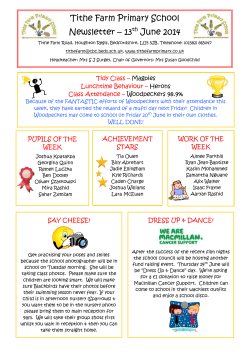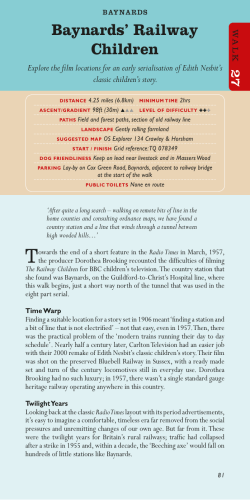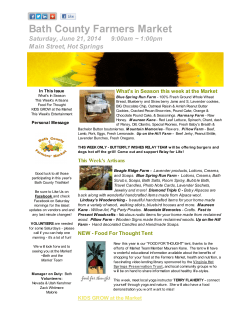
Issue 1 Ranching For Profit Working Together to Create a
Working Together to Create a Hopeful Future For Family Farms Issue 1 Welcome to the first issue of our six installment series dedicated to your farming and ranching success! We hope you find it informative and useful. The theme of this first issue is Business Planning. Many of us find planning difficult, especially with the complexity that surrounds today’s agricultural environment. But the most resilient farms have written plans as their roadmap to success. This issue was written with that in mind. We do hope you will take the time to read, learn and begin writing your farm business plan. Please join us for our first seminar “Generating Wealth: Keys to a Profitable Ranch Business” on Monday, August 15 from 6-9 pm at Columbia Gorge Community College, Building 2, Room 2.384 in The Dalles, OR. Participant costs are $20 per person or $30 per management team. To register contact OSU Extension Service at (541)296-5494. Presenter Dave Pratt of the “Ranching for Profit School” promises to make it well worth your while. Stay cool, Cheryl Williams-Cosner Project Coordinator cosner@bmi.net In This Issue The Soul of Business. ............... 1 Ten Reasons To Do a Business Plan............................................3 The Farm Business Plan Outline.......................................5 Resources...................................8 Ranching For Profit The Soul Of Business Profit is to business as breathing is to life. However, breathing is not the purpose of life. Likewise, profit is not the purpose of business, but it is essential for its survival. Without profit, a ranch isn’t a business, it is a hobby, and usually an expensive one at that. If profit isn’t the purpose of business, then what is? A lot of farmers and ranchers have a tough time identifying the purposed of their business. They often cite, “providing an income for my family” or “creating opportunities for my kids.” If that applies to you, then your farm isn’t really a business as much as it is a collection of jobs. But providing jobs for people sounds more like a purpose of a government program the purpose of a business. At a recent Executive Link meeting Gregg Simonds, said, “You can only serve yourself through service to others.” Yes, a business should provide profit for the owner, salaries for the employees, and opportunities for family members, but the primary function of business must be to serve others. That purpose may be to produce wholesome food from a sustainable landscape. It may involved enriching the lives of customers through sharing rural values and education them about what it takes to produce healthy foods from healthy lands. Whatever it is, it should inspire you and the people who work with you. Mission statements have become sort of a new age management mantra. We see them everywhere. And when companies like Enron talk about things like “respect, integrity, communication and excellence” then can ring pretty hollow. “This material is based upon work supported by USDA/CSREES under Award Number 2004-49200-03123.” Ranching For Profit: The Soul Of Business (con’t) But just because some companies talk the talk but fail to walk the walk doesn’t mean that identifying your business’ core purpose isn’t important. Why is this so critical and what good does it do for a business to have and work to fulfill a mission statement? The bottom line is that it can dramatically improve the bottom line. As I’ve already said, there is more to life and business than money. Finding that higher purpose usually leads to increased profit. In their book “Built to Last” the authors, James Collins and Jerry Porras identified “visionary” companies. These were companies that had identified and pursued a vision beyond profit and had made an indelible impression in their field. Then they compared these companies to other highly successful companies in their respective fields. Among other things they found that the companies that pursued a vision beyond profit were more than twice as profitable as the purely profit driven companies. There’s another critical reason to clearly define the purposed of your business. It is key to keeping you energy level high and, as Joel Salatain puts it, to “romancing the next generation” back to the ranch. As important as profit is to business, people are not motivated by money. In fact, money is negative motivator. Under pay someone and they’ll be upset. Pay someone more than their worth and you won’t get more or better work from them. Stan Parsons used to tell me, you can buy someone’s hands, but you can’t buy their heart and that’s where their loyalty lies. Nor can you buy their mind, and that’s where their creativity originates. So how do you learn loyalty and unleash creativity? Recognition, assigning responsibility and delegating authority are big pieces of this picture. In fact that’s why monetary bonus program can be so effective. It isn’t the bonus that motivates people as much as the recognition of achievement that the bonus implies. Another huge piece of the motivation puzzle is purpose. People want to work toward something bigger than themselves and bigger than you. Employees don’t go to work each day because they want to make their boss rich. They go to work because they need a paycheck. But they show up on time, do quality work enthusiastically, come up with ideas to improve their own performance and stay until the job is done, when they believe in the purpose behind their work. People aren’t motivated by money to reach for the stars. They are motivated to reach for the stars, because the stars excite them. The passion this creates is key to keeping energy high when times get tough. Economics is the heart of the business. But a business without purpose doesn’t have a soul. A sustainable business has to have a heart, but it’s also got to have a soul. David Pratt, is President of Ranch Management Consultants, Inc. In Fairfield, California, and teaches the Ranching for Profit School. For more information call: 707-429-2292. E-Mail: pratt@ranch management.com or visit www.ranchmanagement.com 2 Ten Painless Steps to Start and Finish Your Business Plan You need to prepare a business plan for your company. Anxious to start, you immediately open your favorite word processing program. But now you’re staring at a blank screen and a blinking cursor that appears to be mocking you. Not sure where to start or what to write first, you flip the computer off and decide that tomorrow is a much better day to work on your plan. After all, the weather is much too nice to be sitting inside on a day like today. Many entrepreneurs and business owners have faced this situation before, but what to do when waiting until tomorrow to start your plan is unacceptable? Follow these 10 tried and true tips to help you complete outstanding business plan. 1. Decide why you’re writing your plan Are you raising money? Clarifying your future? Launching a new venture? Searching for strategic partners? Game-planning to destroy your competition? Whatever the reason is it’s important to get committed to the business plan writing process. Prepare for yourself a short paragraph that outlines why you are writing a business plan and why it will be great. Call it your business plan mission, it will keep you motivated and help you clarify the message you send your readers. 2. Get the big picture Before accumulating mountains of research and information, take a look at your business plan through a wide-angle lens to get the big picture. Visit your local library or bookstore and bring home a few business plan books. Take a look at Internet resources, consider business plan software programs and review the SBA's business planning outline. Your goal is to get a feel for what a business plan is, what it isn’t and what to expect from your business plan. With this new insight, prepare an outline that includes the major sections and subsections that you believe should appear in your business plan. 3. Grab everything that’s already handy Dig through every computer file, box and file cabinet you have to unearth the information that’s already available to you. You’ll surprise yourself with what you find and with how nicely this step will move you forward. Consider marketing pieces you’ve prepared, press releases, related articles, industry journals, historical financials, important web sites and notes or ideas you’ve accumulated over time. Don’t rate the quality of this information just gather it. At this point quantity is the name of the game, and the more you can find the better. 4. Just type! Start typing thoughts, ideas, words, questions and to-dos into each section of your business plan outline. Put rough thoughts on paper and empty your brain. Don’t worry about complete sentences or proper grammar, just type. Approach this step like a brainstorming session, the more powerful the storm, the more potent your business plan. Jot down any ideas that demand further consideration, areas that present a challenge and topics that require the input of others. Strive to place your thoughts in the most appropriate section of your business plan outline and rearrange the outline if it will be more logical for your readers. 5. Prepare a rough draft Now it’s time to take your outline, the information you’ve got handy and your brainstormed ideas and shape them into a useable rough draft. Move through your entire outline, section by section and begin writing complete sentences and paragraphs. As you work, start a Biz Plan To-Do List to keep track of topics that require in-depth research, statistics or backup information. When you’re done, print out a copy and read it a few times, revising lightly as you go. Your plan should be rather sparse, but when you’ve completed this step, you’ve truly made business planning progress. 6. It’s research time Now is the time to think like a lawyer and build a case for your business plan. Your goal is to compile information and research to support the claims and assertions you make in your plan. Drop by the library and ask the librarian if she knows of any sources of information that can help your cause. Schedule a meeting with a local SBA representative or a Small Business Development Center counselor. Call your local and national industry associations and track down annual reports for companies in your industry. Request product and service information from your competitors. In short, talk to anyone and everyone that might be able to help you collect information for your business plan. 3 Ten Painless Steps to Start and Finish Your Business Plan (con’t) 7. Start thinking about the numbers It is advisable to begin developing your pro-forma financial statements at this point. If you start any sooner, one of two things is likely to occur: 1) Your numbers will be based on pure fantasy and you’ll have to change them anyway, or 2) You’ll attempt to write your plan, do the research, revise your plan and complete your financial statements all at once and none of it will get done. If you prepare your financial statements at this stage, your numbers have a much better chance of matching and supporting the text in the body of your business plan. For example, if you mention a specific marketing medium in your marketing section, you'll need to include the corresponding costs somewhere in your financials. 8. Write a final draft and finish the numbers Sometimes finishing is the hardest part of completing large projects like a business plan. But if you follow the steps leading up to this one, success is just around the corner. Avoid the mistake many business planners make at this stage It is important to check, double-check and triple-check your writing for grammatical and spelling errors. Think of it this way bankers and investors will assume that you will manage your business and protect their money with the same level of care and attention that you demonstrate in your business plan. Go all out and create a document that sends a powerful message about the quality of your work. 9. Set a deadline To ensure that you complete your plan, set a deadline for yourself that you can’t ignore. We suggest calling a few people you respect to ask if they would be willing to read your plan and offer suggestions. Make this arrangement with someone whom you are not particularly close with, possibly a professional acquaintance, so it’s more difficult and uncomfortable to call and delay. Ask for feedback and make it clear that honesty is what you are after. If you don’t explain this up-front, you may hear “looks good to me” essentially a waste of time for both of you. If you feel tears coming on as they serve up their advice, things are going well. Take detailed notes and refrain from crying until after the phone is back on the receiver. 10. Polish your plan to perfection The comments you receive from your readers will help you to beef-up the sections of your plan that need attention. Track down any additional information you may need, incorporate the ideas that your readers offered and clarify sections or points that were not clearly conveyed. Put together an appendix if necessary, create a clean cover page and table of contents and include a non-disclosure form. Lastly, prepare a one-page executive summary that encapsulates the highlights of your entire business plan and place it up front. Walk into your local print shop like you own the place and professionally print and bind as many copies of your plan as you need. Congratulations, you’re the proud owner of an excellent business plan. Bill Fideccia is principle owner of his business planning consulting firm, Bizplanit. For more information and resources on business planning, visit www.bizplanit.com. 4 Farm Business Plans: A Guide for Creating Your Plan When was the last time you sat down and evaluated your farm on paper? A farm business plan can help you to develop a clear and precise description of all aspects of your operation. It enables you to see the potential profitability of your operation and explain it to others. It puts information at your fingertips while assisting you to develop a stronger understanding of the industry as a whole. A farm business plan can help you to assess the potential of new markets and production methods on paper so you can understand the risks without loss to your operation. A farm business plan will assist you to set and achieve goals for your operation. Why A Farm Business Plan? • Planning guide for marketing, production, finance and human resources. • Proof of management skills and credibility of operation and manager. • Guide to the running of the farm operation. • Communications tool for owner, investors and farm employees. • Complete cost calculation with hands-on information. • Aid to estate planning. • Assessment of strengths, weaknesses, opportunities and threats within the farm operation. Elements of a Business Plan • Business Overview • Marketing Plan • Human Resources Plan • Production Plan • Financial Plan • Goals • Appendix While a business plan is divided into various sections, all the elements are inter-related and draw upon one another in the construction of a well thought out plan. It is important that the information contained in each section of the plan you develop is concise and clear and includes an evaluation of the strengths, weaknesses, opportunities and threats which apply to the plan. Each farm business is unique. Your business plan should address all the points which are pertinent to your business. 1) Title Page: The document title, the name of the farm or business, person(s) who have prepared the plan and the date. 2) Table of Contents: Titles and page numbers of the various sections and sub-sections of the document. 3) Mission Statement: Concise statement describing purpose of business. 4) Business History: Recent information on the development of the farming operation. 5) Business Profile/Executive Summary: Overview of the Business Plan. Should be concise and clear. Prepared last, read first. 6) Business Organization: Type of business: partnership, sole proprietorship or corporation. Management structure, names of principals. Marketing Plan 1) Description of Industry/Where Operation Fits: Part of the agriculture industry you operate within, commodity produced, where operation fits, size of operation. 5 Farm Business Plans: A Guide for Creating Your Plan (con’t) 2) Market Sales: Volume of sales, annual sales. 3) Trends: Past and current industry trends, effects on business. 4) Political/Legal Aspects of Marketing: Trade and tariff regulations, political implications of international sales, provincial or federal legislation, which affects marketing. 5) Competition: Other producers who vie for market share, view to competitive edge. 6) Customer Analysis/Response: Identify customers, response to customer demands. 7) Target/Future Sales: Sales targets, new markets for product, anticipated growth in market share and sales. 8) Pricing: Price setting, calculation of costs, profit margins, market prices. 9) Promotion/Advertising: Details on promotion and advertising. 10) Distribution: Shipping and delivery. Human Resources Plan 1) Organizational Chart: Chart or diagram of the management/employee structure of operation. 2) Employee Plan: Number of employees, hiring procedures, qualifications. 3) Compensation and Benefits: Method of pay, amounts, benefits and incentives. 4) Labor and Training Goals: Training for owners and employees, level of skill, training assistance programs accessed. 5) Owners/Managers: Management Skills/Background: Experience and skills, farm managers track record, specific training in the managing of a business. 6) Job Descriptions: Descriptions of job duties. 7) Roles/Responsibilities/Authority of Management and Employees: Lines of authority, discharge of duties. 8) Employee Goals: Goals of employees within business. Production Plan 1) Land, Buildings and Facilities: Description of land, buildings, facilities owned or used by the farm operation. 2) Equipment: Description of equipment, vehicles, machinery used in farm operation. 3) Materials and Supplies: Description of materials, supplies used in farm production. 4) Production Strategies: Production procedures, what to produce, when to produce it, when to market. 6) Environmental Assessment Plan: Soil conservation, water quality control, manure management practices and product safety controls. 6 Farm Business Plans: A Guide for Creating Your Plan (con’t) 7) Political and Legal Aspects of Production: Zoning, environmental policies, laws which regulate products. Quality control regulations, inspection requirements. Financial Plan 1) Income Statement: Most recent and projected statements of farm income and expenses. 2) Cash Flow Summary: Summary or graph of projected cash flow requirements for a year of operation, monthly or quarterly budgets. 3) Balance Sheets: Most recent and projected balance sheets and/or net worth statements, including farm assets, liabilities, equity. 4) Capital Sales, Purchases: Machinery, land and/or buildings which will be bought or sold. 5) Loan Summary: Summary of outstanding loans, mortgage amounts, rates of interest, payment schedules. 6) Financial Performance Indicators: Measures of liquidity, solvency, profitability and efficiency. 7) Risk Assessment: Effects market down turns, production setbacks could have on the farm operation, risk management tactics. 8) Contingent Liabilities: Potential liabilities - guarantees of indebtedness of others, possible litigations, income tax implications. 9) Historical Prices: Charts or graphs of commodity and input prices over past number of years. Goals 1) Short Term: Goals for next two years of operation. 2) Long Term: Goals for next 3 - 10 years. 3) Constraints to Business Goals: Hindrances to achievement of short and long term goals. 5) Family Goals: (If business is a family farm.) Family goals - complement or conflict with business goals. Appendix 1) Farm Map: A map of farm property including layout of buildings. 2) Past Statements: Financial statements for past 2 - 5 years. 3) Pictures: Pictures of farm operation, buildings, major equipment. 4) Schedules: Supporting data/lists for financial statements. 5) Curriculum Vitae (C.V.) of Owners/Managers: Resumés of farm managers/owners. Adapted from The Canadian Farm Business Management Council. & with the Prince Edward Island Department Fisheries and Forestry 7 of Agriculture, Resources Websites and Internet Resources: The Canadian Farm Business Management Council. Downloadable farm business plan outline featured in this newsletter. http://www.farmcentre.com/english/downloads/pdf/fbpeng.pdf BizPlanit Consulting Firm: Business planning books, business plan software and free newsletter. http://www.bizplanit.com/index.html Cornell University Small Farms Website: Numerous articles and resources on financial, marketing, value added and business planning for farmers and ranchers who wish to maximize their business. http://www.cfap.org/afs_temp3.cfm?topicID=387 Oregon State University Small Farms Website: Publications and links to many useful resources for developing alternative markets with small acreages. http://smallfarms.oregonstate.edu/ Washington State University Small Farms Website: Resources and educational opportunities to learn more about planning a successful agricultural business. http://smallfarms.wsu.edu/about/smallFarmsProgram.html Oregon Small Business Development Network Website: Small Business Development Center Office locator, business plan basics, free one-on-one business counseling. http://www.bizcenter.org/ Books and Print Resources Your Business Plan: A Workbook For Owners of Small Business, Dennis J. Sargent. Oregon Small Business Development Center Network, Eugene © 1989 Develop Your Business Plan, Richard Leza and Jose F. Placencia. Oasis Press, Milpitas. © 1988 Watch For These Topics in Upcoming Issues! Next How Do You Run an Effective (and Friendly) Family Meeting? How Does Your Personality Affect How You Deal With Debt? What Does a Lender Look For in Your Loan Application? ......the answers may surprise you! 8
© Copyright 2025











